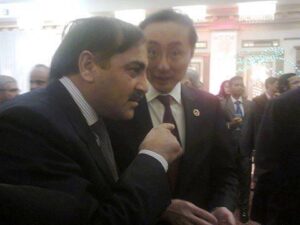By Qamar Bashir
President Donald Trump, in his latest tweet, made it clear that he will impose tariffs on
all countries without exception. To ensure fairness, he announced a Reciprocal Tariff,
meaning the U.S. will charge the same tariff rates that other countries impose on
American goods—no more, no less. He further declared that countries using the VAT
system will face equal tariffs, and those routing merchandise, products, or goods through
third-party nations to harm the U.S. economy will not be tolerated. Additionally,
countries that provide subsidies to their industries, enforce non-monetary trade barriers,
or restrict U.S. businesses from operating will face penalties. However, he welcomed
foreign companies to shift their manufacturing units to the U.S. to avoid tariffs.
Like Tariff, from the US perspective, VAT is equally punitive for the U.S. because it
creates an uneven trade environment by imposing taxes on American imports while
allowing VAT-based countries to rebate taxes on their exports, effectively subsidizing
their goods. This disadvantages U.S. businesses by making their products more expensive
abroad and incentivizing companies to relocate production to VAT-based nations.
Countries using the VAT system that would be highly affected by an executive order
addressing this issue include major trading partners like the European Union (Germany,
France, Italy, Spain), China, India, Canada, Mexico, Brazil, Australia, and several others
across Asia, Africa, and South America.
Countries that provide subsidies to their industries, enforce non-monetary trade barriers,
or restrict U.S. businesses from operating create an unfair trade environment that harms
the American economy. These practices allow foreign companies to sell goods at
artificially low prices, undercutting U.S. manufacturers and leading to job losses. Non-
monetary barriers, such as excessive regulations and restrictions, prevent American
businesses from competing fairly in international markets, reducing export opportunities
and widening trade deficits.
Additionally, blocking U.S. companies from operating in certain countries while allowing
their own firms to access the U.S. market creates an imbalance that weakens domestic
industries.
Countries that route merchandise, products, or goods under different classifications
through third-party nations to evade tariffs or gain unfair trade advantages harm U.S.
businesses and the economy by flooding the market with artificially cheaper imports.
This practice undermines American manufacturers, reduces domestic job opportunities,
and leads to trade imbalances that weaken U.S. industries. Countries that engage in these
practices, such as China, Vietnam, Malaysia, Mexico, and certain EU nations, would be
most affected by this policy, as they often use intermediary nations to bypass trade
regulations and maintain access to the U.S. market under preferential terms.
Critics argue that President Trump's direct approach appears to be akin to a complete
overhaul, as if the United States is a new nation with no past history. History shapes the
tariffs, subsidies, and trade barriers—wars fought, debts unsettled, alliances forged, and
nations rebuilt. Japan and Germany rose under American security after World War II,
China leveraged U.S.-created trade rules to ascend, and Europe’s high-tax, high-benefit
model emerged from centuries of upheaval. True reciprocity in trade would require
erasing this history, undoing past subsidies, military protections, and preferential access
once granted to developing economies. But the critical question remains: when does
protectionism stop being a ladder for growth and become a crutch that prevents self-
sufficiency? At what point does a nation transition from “developing” to “fully
developed”?
Having said this, the fact remains that for years, the U.S. has been treated unfairly in
trade, both by allies and rivals, and the push for reciprocity aims to restore fairness and
prosperity. However, pure reciprocity assumes that all nations start from the same point,
which is far from reality.
Trade is not a balanced chess game, but rather a high-stakes poker match, where some
players possess substantial reserves, while others face initial difficulties. The U.S. runs
trade deficits not because of weakness, but because the dollar is the world’s reserve
currency, creating an endless demand for U.S. assets.
This imbalance is not a flaw but a fundamental design of global trade. Surpluses are not
inherently good, just as deficits are not inherently bad. The real question is not just about
lowering tariffs but whether the U.S. should rethink its entire economic strategy.
Should it embrace economic nationalism, bringing industries back home at the cost of
higher prices? Or should it leverage its unique advantages—dominance in global finance,
technology, and energy—to shape the trade rules in ways no tariff ever could?
Reciprocity is a starting point, not a final solution. History shows that trade fairness is not
just about numbers; it’s about vision, leverage, and understanding the broader game.
It is though true that trade is complex, shaped by history, war, and economic policy—but
it does also not change the fact that other countries impose higher tariffs on the U.S. than
the U.S. does to them.
Matching their rates isn’t unfair; it’s leveling the playing field. At what point do nations
like Germany, Japan, and China stop receiving special treatment? WWII ended nearly 80
years ago, yet China, now the world’s second-largest economy, still benefits from rules
designed for struggling nations—that’s not fairness, that’s the U.S. getting played.
What’s truly unfair is expecting America to keep following different rules while other
countries protect their industries. More than just tariffs, the real solution lies in
reclaiming control of US manufacturing base and securing critical inputs.
The new administration recognizes this challenge and is actively working to reshore
manufacturing by offering incentives for companies to bring production back to the U.S.
through infrastructure investments, targeted subsidies, and revamped trade policies. This
effort isn’t just about job creation—it’s about securing America’s economic
independence in an increasingly fragmented and competitive world.
While tariffs alone won’t accomplish this, strategic domestic investment will. This is a
long-term vision for true economic sovereignty, where American industries thrive within
a self-sustaining, resilient economy, not relying on the goodwill of foreign competitors.
The future of trade won’t be about playing nice; it will be about securing national
strength through self-reliance and smart policy.




